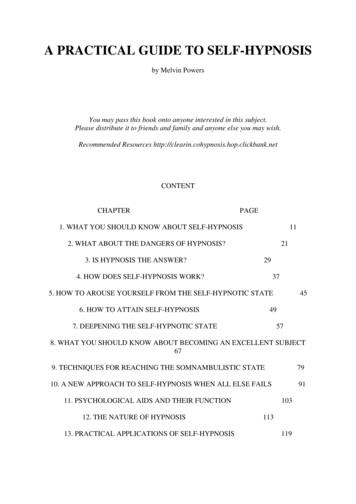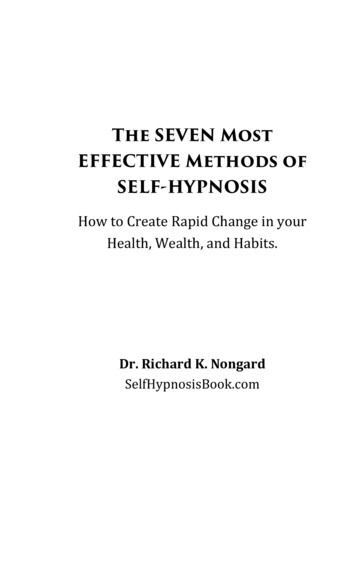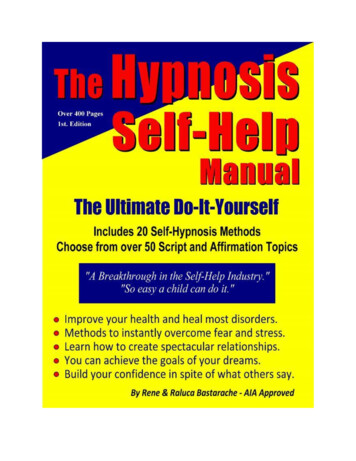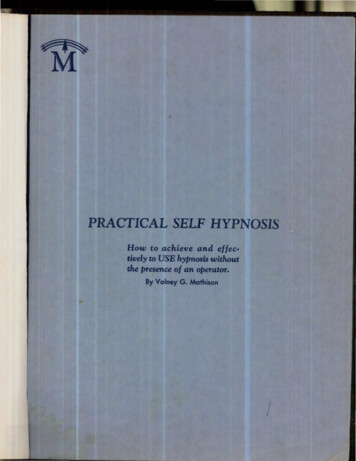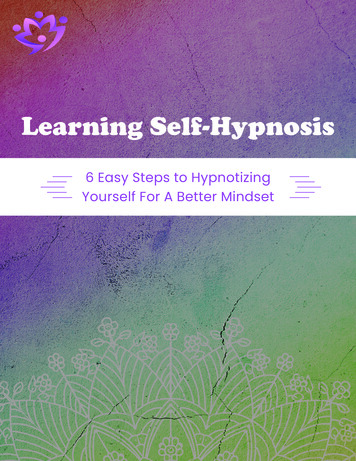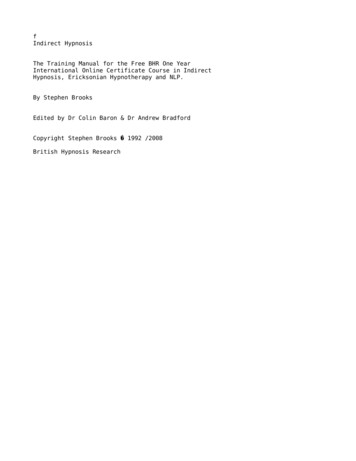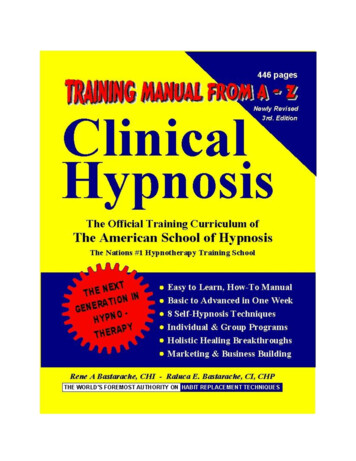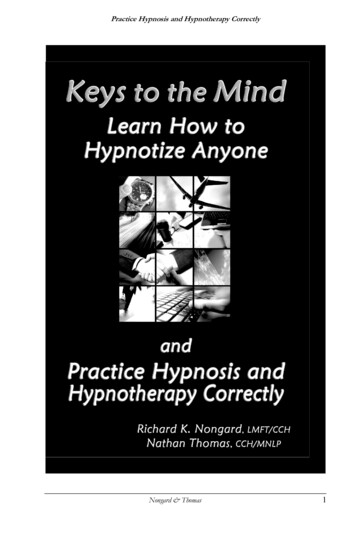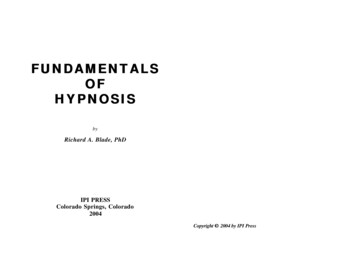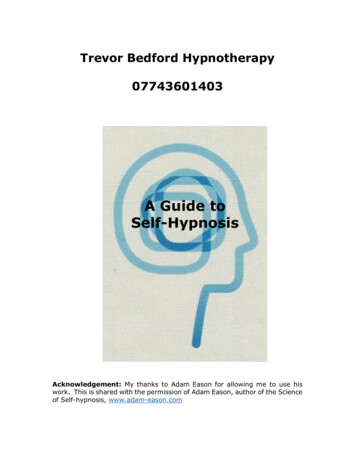
Transcription
Trevor Bedford Hypnotherapy07743601403A Guide toSelf-HypnosisAcknowledgement: My thanks to Adam Eason for allowing me to use hiswork. This is shared with the permission of Adam Eason, author of the Scienceof Self-hypnosis, www.adam-eason.com
Trevor Bedford HypnotherapySelf-HypnosisContentsIntroduction. 3Self-Hypnosis Skills Training . 3Overview . 3What can Self-Hypnosis be used for? . 4The Overall Process in Outline . 6Preparation . 6Hypnosis. 6Deliver your “script” . 7Enjoy the re-orientation . 7Preparation . 8Script writing suggestions . 8Preparation . 8Use the right Words . 9Suggestions for pain control . 10Self-Hypnosis Techniques . 11Music as a Background . 11Eye-Fixation Exercise . 12Basic Instructions . 12Initial Relaxation. 13Fractional Relaxation . 13Allow yourself to go Deeper . 14Hints & Tips . 15Deliver the “script” . 17Three Self-hypnosis script absorbing methods . 17Reading your own script . 17Open eyes . 17Recording your suggestion . 17Re-orientation . 19Alternative methods of inducing self-hypnosis . 20Heavy Arm Self-Hypnosis Induction Method: . 20Floating Arm Self-Hypnosis Induction: . 22Final Point . 25Mobile 07743601403P a g e 2 25
Trevor Bedford HypnotherapySelf-HypnosisIntroductionHypnotherapy is the use of hypnosis to help a person make changes toimprove their life. You want to make change. The therapist can helpyou understand what changes you can and want to make. You may notalways be able to change circumstances, in that instance the therapistguides you on how you can change your perception.Using hypnosis is the magic part of helping you imagine, visualise andachieve that change.It is important that you take responsibility for the change. Hypnosis isnot a hypnotist doing something to a person, rather you visualising andimaging what you can and will do to make the change.Teaching yourself self-hypnosis helps you establish that responsibility.This is very powerful when tackling change. Rather than give you fishto eat, I believe in providing you with a fishing rod and helping you learnhow to catch your own.Hypnosis differs from Mindfulness and Meditation, which are similar inmany ways and also include deep relaxation. The main difference is theuse of imagination and focus during hypnosis which is extremelypowerful in helping you achieve your aims.Self-Hypnosis Skills TrainingOverviewStart with short sessions often, ideally ten minutes, twice a day, forfourteen days. This should be the minimum training period you aim toachieve. You don’t need hours. Ten minutes can be extremelypowerful. As your confidence grows, you may find you increase theamount of time and frequency of sessions. There is no right or wrongprescription, do what you are comfortable with doing.Anxiety is one of the main obstacles to learning self-hypnosis. Peopleworry about whether they will "get it right" and this leads toperformance anxiety, which makes them tense and distracts their mind,thereby interfering with their learning and performance.Take your time; don't rush things. Be patient. Make repeated attempts.Approach the whole subject as an opportunity for gradual "trial anderror" learning. Realise that you are not learning a completely new skill.You already know how to use your imagination, everyone does, you doMobile 07743601403P a g e 3 25
Trevor Bedford HypnotherapySelf-Hypnosisit every day. You're learning a new way of using your existingpsychological skills and abilities.Think positively. Hypnotism was originally defined in terms of focusedattention upon "expectant ideas." That means part of the technique isto cultivate a sense of self-confidence about what you are doing. Havefaith in yourself, believe that you can do it.Set realistic expectations. Research suggests that people who havedramatic and unrealistic expectation about self-hypnosis tend to makeless progress than those who are able to observe others using the sametechniques and listening to them describe how it felt.High levels of motivation, positive attitudes, absence of misconceptions,and realistic expectations, tend to increase people's ability to learn selfhypnosis.What can Self-Hypnosis be used for?Hypnosis is mainly used by hypnotherapists for achieving the client’spersonal improvement.Self-hypnosis can be used in the same way, with the added benefit thathere you are taking responsibility for the hypnosis, the belief and theoutcome.Some of the benefits include: Improved exam techniques, being more relaxed and focused withimproved clarity and powers of memory recallImproved sports performance, higher powers of concentrationand focusChanging patterns of behaviour – alcohol, smoking, eating,gambling by imagining what you do want.Changing anxiety into excitement and anticipation to do thethings you want to doLifting your mood so those melancholy periods becomes shorterand less intense and the happy moments become real and longerlastingIncreasing motivation to do the things you want to do and haveto do so you change your perspective and start to enjoy so muchmore in your lifeImproving sleep patterns and quality of sleep to wake each dayfeeling more refreshed.Mobile 07743601403P a g e 4 25
Trevor Bedford HypnotherapySelf-Hypnosis Disassociating from pain by reducing or controlling it in ways thathelp you cope betterReducing stress-related illnesses such as ME, migraines, IBSChanging your perspective in life to overcome any angermanagement issues or lack of tolerance.Mobile 07743601403P a g e 5 25
Trevor Bedford HypnotherapySelf-HypnosisThe Overall Process in OutlinePreparationPlan what you are trying to achieve. This can be a very specificobjective – to drive into Exeter feeling relaxed and calm, lookingforward to spending quality time with friends. It could be a very generalobjective – to wake feeling good, confident and calm.You can write down exactly what you want to achieve, record it or justthink about it.Once you know what you want this session to focus on make sure youare in a safe place and have the intention to go into hypnosis.HypnosisMany people like to start by breathing 7/11. Breath in counting to 7,imagining cool, relaxing air filling your lungs with oxygen and energy,breath out counting to 11, imagining breathing out all the worries,troubles, pains and fears. Expelling all the carbon dioxide and poisons,emptying your lungs. Repeat three or four times so you can start thehypnosis in a calm and relaxed state of mind.Use the induction protocol you find most beneficial. If you use eyefixation for instance, then once your eyes close, just relax and enjoythe peace for a while before allowing yourself to go deeper.Re-enforce you are safe and in control I am in a deep Hypnotic trance and I am in full controlI will respond only to my intended suggestions.I am fully protected from any random thoughts, images andsounds becoming hypnotic suggestion.To go deeper into hypnosis, allow yourself to imagine whatever you findrelaxing.These can include: Counting down from 10 to 1, imagining going deeper with everystep downSeeing yourself becoming more relaxed by imaging each part ofyour body, the muscles, tendons and ligaments all relaxing oneby oneMobile 07743601403P a g e 6 25
Trevor Bedford HypnotherapySelf-Hypnosis Enjoy a scenario that is right for you, a walk through a forest,sailing on a lake, flying into space.Deliver your “script”Read, play back a recording or remember a title to deliver your plannedobjectives for the session. Use the voice inside your head to deliver themessage in a way that is meaningful to you. Use passion and purpose.If you are motivating, then use passion. If you are focusing on sleepthen use a quiet and relaxing voice.Really imagine everything you are suggesting, be appropriatelyenthusiastic and assure yourself of it. Be convincing.Enjoy the re-orientationYou don't need an elaborate routine to emerge from meditation. Youmight find it takes a few moments to get your bearings, if you've beenextremely deeply relaxed, of course. You can just open your eyes whenyou feel ready and perhaps stretch, rub your eyes, or take a few deepbreaths. Alternatively, you can count yourself out of self-hypnosis bycounting from one to five (or ten) while you imagine becoming moreactive and alert.Mobile 07743601403P a g e 7 25
Trevor Bedford HypnotherapySelf-HypnosisPreparationScript writing suggestionsThis is where you decide on what you want to achieve from theIn hypnotherapy a therapist guides and teaches a client to setrealistic and achievable goals. On your own this is the samebecome even more powerful as you practise and learn. Yourbe to be more focused in a specific situation, or general as into be more confident or happy.session.specific,and canaim canwantingPreparation Write down what it is that you want, not what you don’t want.What is the outcome you most desire?How would you like to feel?How would you like to be?What will the benefits be?Deal, if possible, with the cause and effect.Write it down and read it through several times or record it and play itback several times. Check that once you have written/recorded the suggestion youput on your editing hat. Have any words entered without yourintention? Are you happy with the finished result?Remember that during this early period as a self-hypnotist, onesuggestion per session can be more successful than giving many.Generally, the best sessions are simple so be specific, concise andprecise.Make sure that you want it to work and expect it to work.The more you want it to work, the more effective your suggestionwill be. If in doubt, write down the pros and cons. Do you reallywant what you have asked for?Think it through and do not proceed if there is any doubt aboutyour suggestion. When in doubt, think about your suggestion. Dowhat you can to remove the ambiguity and only then proceed.Ask for what you want, not what you do not want, stating yourgoals in the positive.Use emotive language to illustrate your passion and desire. Usegreat, fantastic, better and better.Say exactly what you mean and mean what you say by use ofclear language, free from ambiguity.Mobile 07743601403P a g e 8 25
Trevor Bedford HypnotherapySelf-Hypnosis Set a time when this change is going to start happening, useanalogy on how it is going to keep getting better every hour, day,week and month.In sessions with specific achievable goals it may be appropriateto suggest a time to finish.Label your suggestions to make it easier to alter, boost or removethem.Use the right WordsPowerful words to useWhat words make you feel good? Which words give you good feelings?Make a list of the words that appeal to you. You can use a thesaurus tohelp. Ask yourself; How would I like to feel?Remember; suggestions work best when you have intense emotioncombined with relaxation.Good words to use in your CalmBetterJoyfulUnisonProgressWords to avoid WordsWordsWordsWordsthatthatthatthatelicit bad feelings.are ambiguousare limiting, restrictive or disempower you.you are uncomfortable with.When you have prepared your script, ask yourself the followingquestions: Is there another phrase or word that is better?Is there a word or phrase I find more pleasing?Is there a way in which you can put your energy and power intothis suggestion in a better way?Words that can elicit bad n’tMobile ldn’tOught toWantWillMustButP a g e 9 25
Trevor Bedford HypnotherapySelf-HypnosisWords that are s that are a put s for pain controlSuggestions for the removal of pain and discomfort should be used asHypnotic Tablets, that are effective for 1-2 hours. This is especiallyimportant when you cannot identify the cause of pain. It ensures thatyou do not ignore the body’s alarm system.When you are recovering from s
Anxiety is one of the main obstacles to learning self-hypnosis. People worry about whether they will "get it right" and this leads to performance anxiety, which makes them tense and distracts their mind, thereby interfering with their learning and performance. Take your time; don't rush things. Be patient. Make repeated attempts. Approach the whole subject as an opportunity for gradual "trial .
